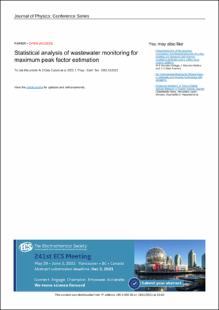Mostrar el registro sencillo del ítem
Statistical analysis of wastewater monitoring for maximum peak factor estimation
| dc.contributor.author | calixto, nelson javier | |
| dc.contributor.author | Bonilla, Carlos | |
| dc.contributor.author | Rojas Suárez, Jhan Piero | |
| dc.date.accessioned | 2021-11-19T13:09:56Z | |
| dc.date.available | 2021-11-19T13:09:56Z | |
| dc.date.issued | 2021-08-09 | |
| dc.identifier.uri | http://repositorio.ufps.edu.co/handle/ufps/1121 | |
| dc.description.abstract | The design and operation of sanitary sewerage systems are based on the knowledge of peak and the average daily wastewater flows. The maximum peak factor is obtained through the ratio of the maximum flow and the average discharge flow of wastewater generated in a system. In this sense, the maximum peak factor was estimated by monitoring wastewater flow in an urban sector of the city of San José de Cúcuta, Colombia. This urban sector represents 45.6% of the sanitary sewerage of the city. Stochastic modeling of the peak flow was performed, and a mathematical model was constructed to estimate the maximum peak factor using a correlational study using statistical methodology. Through linear regression analysis, a model was obtained that estimates the value of the maximum peaking factor based on knowledge of the average daily wastewater flow. The results indicate that the model is potential, and the expression is statistically significant and satisfies the assumptions established for the classical linear regression model. | eng |
| dc.format.extent | 07 páginas | spa |
| dc.format.mimetype | application/pdf | spa |
| dc.language.iso | eng | spa |
| dc.publisher | Journal of Physics: Conference Series | spa |
| dc.relation.ispartof | Journal of Physics: Conference Series | |
| dc.rights | © Copyright 2021 IOP Publishing | eng |
| dc.source | https://iopscience.iop.org/article/10.1088/1742-6596/1981/1/012013/meta | spa |
| dc.title | Statistical analysis of wastewater monitoring for maximum peak factor estimation | eng |
| dc.type | Artículo de revista | spa |
| dcterms.references | Rodríguez J 2013 Monitoring and modelling to support wastewater system management in developing mega-cities Sci. Total Environ. 445–446 79 | spa |
| dcterms.references | Shuvalov M 2020 IOP Conf. Ser.: Mater. Sci. Eng. 775 1 | spa |
| dcterms.references | Chernosvitov L 2019 IOP Conf. Ser.: Earth Environ. Sci. 272 1 | spa |
| dcterms.references | Al-Hadithy Azzam H 2019 J. Phys. Conf. Ser. 1294 1 | spa |
| dcterms.references | Poensgen-Llano N 2011 Análisis del Comportamiento Espacio-Temporal de los Caudales Residuales en la Cuenca Urbana del Río Salitre (Colombia: Pontificia Universidad Javeriana) | spa |
| dcterms.references | Empresas Publicas de Medellin (EPM) 2013 Normas de Diseño de Sistemas de Alcantarillado de EPM (Colombia: Empresas Públicas de Medellín) | spa |
| dcterms.references | Touny M 2020 Peak factors for sewerage system in upper Egypt communities Bull Fac. Eng. Mansoura Univ. 45 16 | spa |
| dcterms.references | Zhang X 2005 World Water and Environmental Resources Congress 2005 (New York: American Society of Civil Engineers) A theoretical explanation for peaking factors | spa |
| dcterms.references | Tirado-Picado V 2013 Determinación del coeficiente de flujo máximo para el diseño de sistemas de alcantarillados sanitarios, evaluado en Managua, Nicaragua Tecnura 17 61 | spa |
| dcterms.references | Imam E and Elnakar H 2014 Design flow factors for sewerage systems in small arid communities J. Adv. Res. 5 537 | spa |
| dcterms.references | Chandragade A and Gupta R 2016 Peak factor curve for estimating peak flows in design of sewer networks: a case study of Gadchiroli city Int. J. Innov. Res. Sci. Eng. 2 162 | spa |
| dcterms.references | Gaines J 2015 Peak sewage and flow rate: prediction probability Water Pollut. Control Fed. 61 124 | spa |
| dcterms.references | Bonilla-Granados C 2019 Determinación del Factor Máximo de Pico para el Diseño de Sistemas de Alcantarillado Sanitario Mediante Monitoreo de Flujo de Aguas Residuales Caso de Estudio: Cúcuta, Colombia (Colombia: Universidad Manuela Beltrán) | spa |
| dcterms.references | Balacco G 2017 Evaluation of peak water demand factors in puglia (Southern Italy) Water 9 96 | spa |
| dcterms.references | Bonilla-Granados C 2019 A systematic review of wastewater monitoring and its applications in urban drainage systems Respuestas 24 54 | spa |
| dcterms.references | Vitto R 2005 Fitting Distributions With R (Boston: Free Software Foundation) | spa |
| dcterms.references | Kotz S and Nadarajah S 2000 Extreme Value Distributions: Theory and Applications (London: Imperial College Press) | spa |
| dcterms.references | Sáenz A 2009 Modelización Estocástica de Precipitaciones Máximas para el Cálculo de Eventos Extremos a partir de los Periodos de Retorno Mediante R (Spain: Universidad de Jaén) | spa |
| dcterms.references | Canavos G 1987 Probabilidad y Estadística. Aplicaciones (México: Editorial Mc Graw Hill) | spa |
| dcterms.references | Díaz-Monroy L 2007 Estadística Multivariada: Inferencia y Métodos (Colombia: Universidad Nacional de Colombia) | spa |
| dc.identifier.doi | https://doi.org/10.1088/1742-6596/1981/1/012013 | |
| dc.publisher.place | Reino Unido | spa |
| dc.relation.citationedition | Vol.1981 No.1.(2021) | spa |
| dc.relation.citationendpage | 7 | spa |
| dc.relation.citationissue | 1(2021) | spa |
| dc.relation.citationstartpage | 1 | spa |
| dc.relation.citationvolume | 1981 | spa |
| dc.relation.cites | Cely-Calixto, N. J., Bonilla-Granados, C. A., & Rojas-Suárez, J. P. (2021, July). Statistical analysis of wastewater monitoring for maximum peak factor estimation. In Journal of Physics: Conference Series (Vol. 1981, No. 1, p. 012013). IOP Publishing. | |
| dc.relation.ispartofjournal | Journal of Physics: Conference Series | spa |
| dc.rights.accessrights | info:eu-repo/semantics/openAccess | spa |
| dc.rights.creativecommons | Atribución 4.0 Internacional (CC BY 4.0) | spa |
| dc.type.coar | http://purl.org/coar/resource_type/c_6501 | spa |
| dc.type.content | Text | spa |
| dc.type.driver | info:eu-repo/semantics/article | spa |
| dc.type.redcol | http://purl.org/redcol/resource_type/ART | spa |
| oaire.accessrights | http://purl.org/coar/access_right/c_abf2 | spa |
| oaire.version | http://purl.org/coar/version/c_970fb48d4fbd8a85 | spa |
| dc.type.version | info:eu-repo/semantics/publishedVersion | spa |










